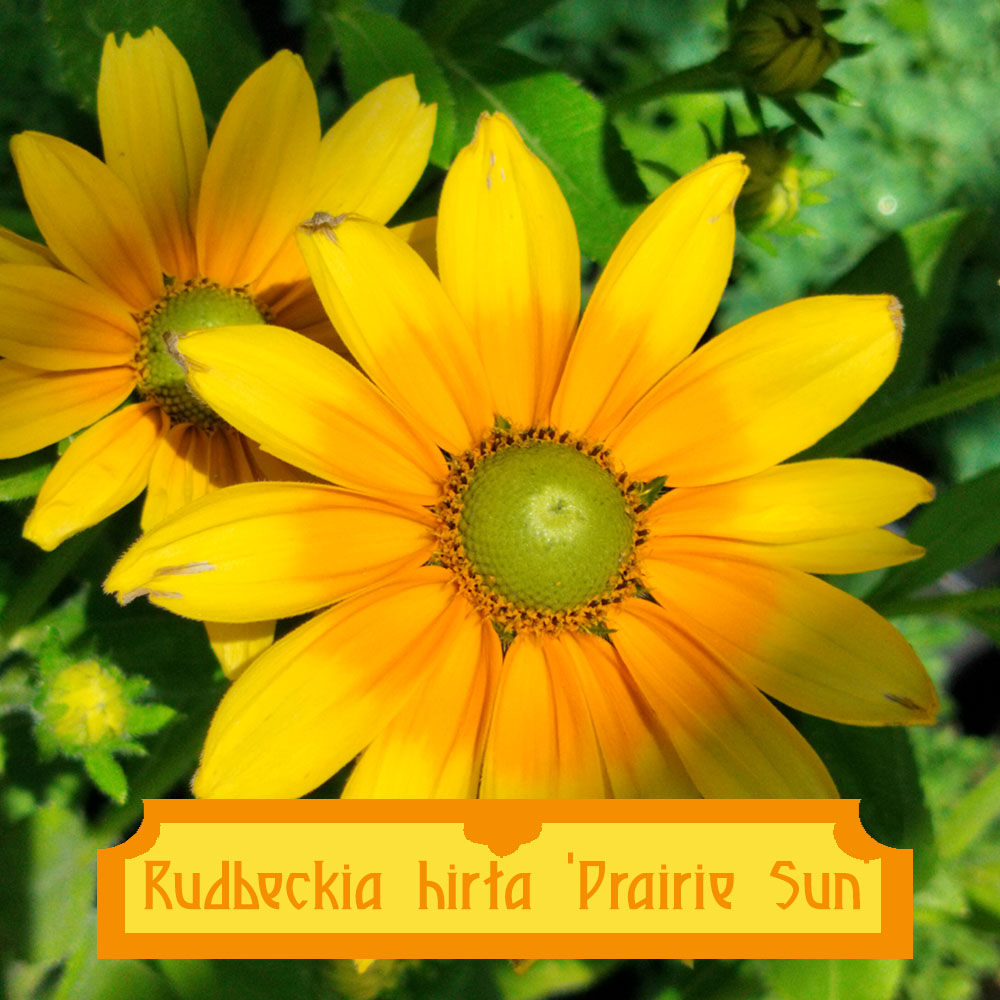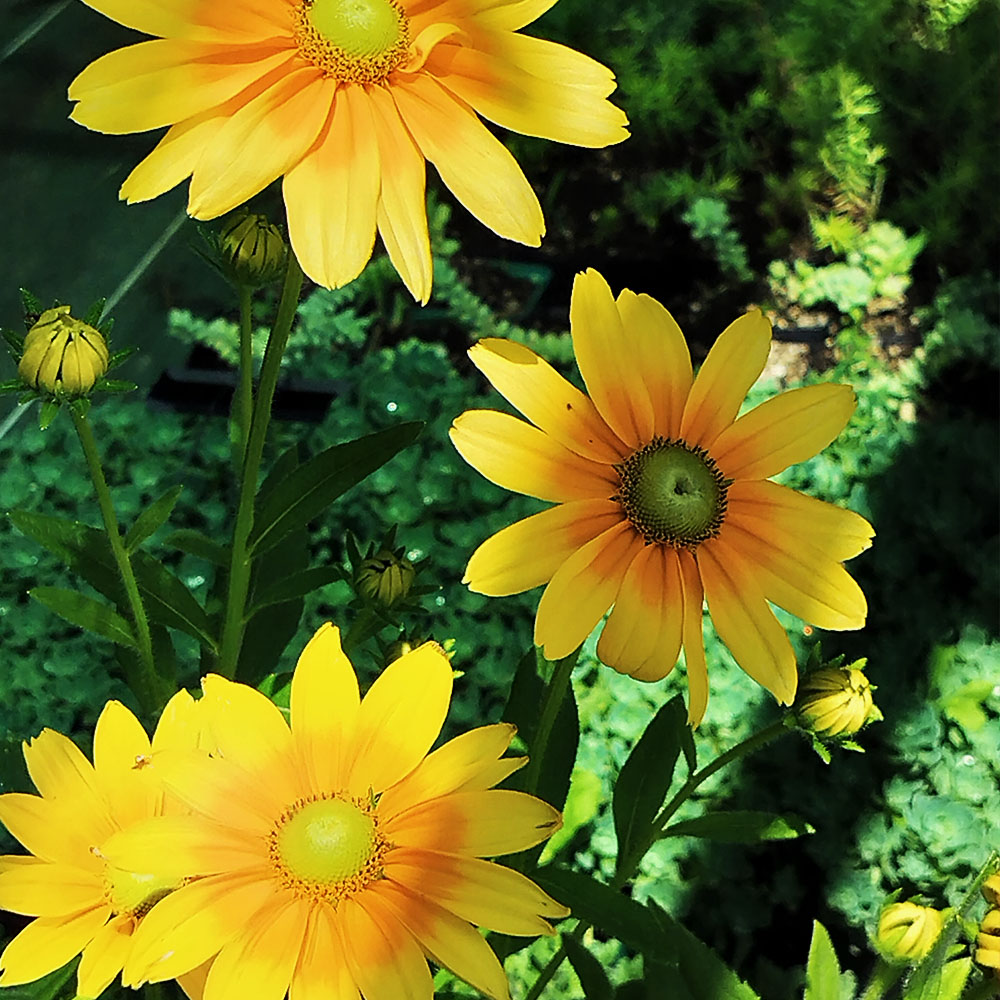No products in the cart.
Rudbeckia hirta ‘Prairie Sun’
A self-seeding annual with bright yellow flowers
Rated 0 out of 5
0 customer reviews
4,90 €
Only 5 item(s) left in stock!
Tags: fleurs, longue floraison, perennial, persistant, plant, secheresse, soleil, vivace
SKU: pda269
Category: Bees and Butterflies, Bouquet, Distillations, Frost Hardy, Ground Cover, Make it Pop, Medicinal, Rewild, The Stunners

Rudbeckia hirta 'Prairie Sun'
4,90 €
Only 5 item(s) left in stock!
Rudbeckia ‘Prairie Sun’ produces hundreds of daisy-like flowers in a single season, ranging from golden yellow to yellow-orange, with bright yellow edges, which open in simple collars around a green center.
The leaves are dual colored – starting with a dark peach at the center and shading out into a butter yellow at the edge.
The leaves are oval and pointed, slightly serrated along the edges, and appear in basal tufts.
The stem leaves are smaller and sessile (without petioles), with a rounded, cordate base; their color is a bright, light green.
The flowers are quite large, attracting both butterflies and passerbys to your garden.
👨🌾 GARDENING TIPS👨🌾:
-
- Easy to grow as an annual, this short-lived perennial quickly forms a medium-sized clump that readily self-seeds.
- It prefers full sun and is content with ordinary, fairly fertile soil, which is fresh to occasionally dry.
- Looks great with Echinacea purpurea, Achillea ptarmica Boule de Neige, Helenium ‘Rubinzwerg’
Learn more about gardening with the Rudbeckia family:
Discover other varieties of Rudbeckia: The Lesser Known Varieties
The Tales & The Botany:
All Rudbeckia species are dye plants (especially R. hirta and R. laciniata) due to the presence of flavonols in their tissues. The inflorescences used alone give orange-yellow colors, while the entire plant provides yellow-green shades.
It is a cultivar derived from Rudbeckia hirta, a short-lived perennial native to the United States.
In the wild in the US, this plant grows in prairies, pastures, and cultivated fields, where it is considered a weed.
The genus name honors Olof Rudbeck (1630-1702) Swedish botanist and founder of the Uppsala Botanic Garden in Sweden where Carl Linnaeus was once a professor of botany.
The species name of hirta means “hairy”, a reference to the short bristles that cover the leaves and stems.
🏆 ‘Prairie Sun’ is an All-America Selection winner in 2003 and a Gold Medal winner at the 2003 Fleuroselect trials in England.
🎨 All Rudbeckia species are dye plants (especially R. hirta and R. laciniata) due to the presence of flavonols in their tissues. The inflorescences alone produce yellow-orange colors, while the entire plant gives yellow-green hues.
🌸 Floral Morphology
The plant itself is a herbaceous perennial, though in many climates it behaves like a short-lived perennial or even an annual.
Its stems are hairy and upright, supporting the flower heads in a way that maximizes visibility to pollinators, while its rough, lance-shaped leaves are adapted to conserve moisture and deter herbivory.
The floral collar is divided into two concentric zones of different colors, a bright yellow border surrounding a central orange-yellow zone.
Interestingly, the hairs on the leaves and stems can also reflect light, slightly reducing leaf temperature and helping the plant survive in open, sunny prairies.
🌱 Reproductive Biology
From a reproductive standpoint, Rudbeckia hirta is prolific. The plant produces small, dry fruits called achenes, which often self-seed around the parent plant.
This self-seeding habit, combined with its long blooming period from mid-summer to early fall, makes ‘Prairie Sun’ particularly resilient in gardens and wildflower plantings.
Its bright yellow flowers are highly attractive to bees, butterflies, and even some birds, highlighting its ecological role beyond simple ornamentation.
🌍 Ecology & Adaptations
Botanically, the cultivar ‘Prairie Sun’ has been selected for its compact stature and consistently vibrant coloration, making it especially suitable for garden borders, prairie-style meadows, and pollinator-friendly landscapes.
Unlike some taller Rudbeckia varieties that can flop over, ‘Prairie Sun’ maintains a tidy, upright habit that is both aesthetically pleasing and practical for small garden spaces.
Its genetic background reflects a balance between wild prairie hardiness and ornamental refinement, giving it both durability and visual appeal.
Other Names:
Black eyed Susan
Origin:
North America
| Weight | 0,5 kg |
|---|---|
| Flowering | July, August, September, October |
| Exposure | Full Sun |
| Frost Tolerance | -25°C to -30°C |
| Soil | Cool, Sandy |
| Size | 0.8m H x 0.4m W |
Reviews
0
Rated 0 out of 5
0 customer reviews
5
0
4
0
3
0
2
0
1
0
Only logged in customers who have purchased this product may leave a review.
You may also like…
Echinacea purpurea
A perennial with purple flowers all summer long
A perennial with purple flowers all summer long
Rated 0 out of 5
Centaurea montana
A perennial thistle with bright blue flowers atop silver green foliage
A perennial thistle with bright blue flowers atop silver green foliage
Rated 0 out of 5
Related Products
Euphorbia cyparissias Clarice Howard
A Euphorbia that resembles a soft little cyprus tree
A Euphorbia that resembles a soft little cyprus tree
Rated 0 out of 5
Cerastium tomentosum var. columnae
A grey-green spreading ground cover from the mountains.
A grey-green spreading ground cover from the mountains.
Rated 0 out of 5
Vinca minor
Looping elegance and ability to form a low flowering ground cover
Looping elegance and ability to form a low flowering ground cover
Rated 0 out of 5
Euphorbia myrsinites
Known for its draping form of silver-gray foliage and radiant blooms.
Known for its draping form of silver-gray foliage and radiant blooms.
Rated 0 out of 5
Artemisia Valerie Finnis
A semi-evergreen, aromatic variation on the theme of Artemisia.
A semi-evergreen, aromatic variation on the theme of Artemisia.
Rated 0 out of 5
Hieracium maculatum Leopard
A native perennial with blue-green leaves and a tall yellow flower
A native perennial with blue-green leaves and a tall yellow flower
Rated 0 out of 5
Delosperma cooperi
A dwarf perennial known for its vermillion colored flowers
A dwarf perennial known for its vermillion colored flowers
Rated 0 out of 5
Glechoma hederacea
A sweet smelling ground cover, producing little blue flowers all summer long.
A sweet smelling ground cover, producing little blue flowers all summer long.
Rated 0 out of 5
Sedum album
A low, multi-color ground cover.
A low, multi-color ground cover.
Rated 0 out of 5
Melissa officinalis
A perennial plant in the mint family that is adored by bees, royal families and tea drinkers.
A perennial plant in the mint family that is adored by bees, royal families and tea drinkers.
Rated 0 out of 5
Kalanchoe daigremontiana
A toothy succulent from Madagascar, known as the Mother of Thousands.
A toothy succulent from Madagascar, known as the Mother of Thousands.
Rated 0 out of 5
Hellebore argutifolius
Winter flowering perennial with marbled blue-green leaves
Winter flowering perennial with marbled blue-green leaves
Rated 0 out of 5
Mentha x piperita ‘Chartreuse’
A spicy mint, known for its use in the production of liqueurs and herbal teas.
A spicy mint, known for its use in the production of liqueurs and herbal teas.
Rated 0 out of 5
Tradescantia Blushing Bride
Gorgeous blushes of pink and white that appear in the coldest nights.
Gorgeous blushes of pink and white that appear in the coldest nights.
Rated 0 out of 5
Tanacetum densum subsp amani
A shrublet composed of soft, finely divided silvery gray-white leaves.
A shrublet composed of soft, finely divided silvery gray-white leaves.
Rated 0 out of 5
Potentilla anserina
A distinctly silvery, silky and lacy perennial.
A distinctly silvery, silky and lacy perennial.
Rated 0 out of 5
Stachys byzantina
Silky white-grey leaves and tall striking flowers
Silky white-grey leaves and tall striking flowers
Rated 0 out of 5
Trachelospermum asiaticum ‘Ogon Nishiki’
Jasmine with colorful foliage and lovely white flowers in summer
Jasmine with colorful foliage and lovely white flowers in summer
Rated 0 out of 5
recent view product
Persicaria microcephala ‘Red Dragon’
A cultivar that dazzles with its deep purple foliage, bright red stems and light white flowers
A cultivar that dazzles with its deep purple foliage, bright red stems and light white flowers
Rated 0 out of 5
Centaurea montana
A perennial thistle with bright blue flowers atop silver green foliage
A perennial thistle with bright blue flowers atop silver green foliage
Rated 0 out of 5
Tradescantia Green Hill
Dark green and purple little leaves
Dark green and purple little leaves
Rated 0 out of 5
Achillea Little Moonshine
A compact yarrow, known for its bright yellow flowers
A compact yarrow, known for its bright yellow flowers
Rated 0 out of 5
Tradescantia pallida var purpurea
A tender perennial known for its striking purple foliage.
A tender perennial known for its striking purple foliage.
Rated 0 out of 5




















































There are no reviews yet.